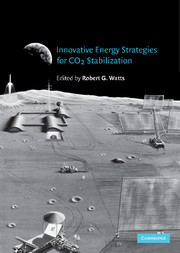Book contents
- Frontmatter
- Contents
- List of contributors
- 1 Concerns about Climate Change and Global Warming
- 2 Posing the Problem
- 3 Adaptive Strategies for Climate Change
- 4 Energy Efficiency: a Little Goes a Long Way
- 5 The Potential of Renewable Energy to Reduce Carbon Emissions
- 6 Carbonless Transportation and Energy Storage in Future Energy Systems
- 7 What Can Nuclear Power Accomplish to Reduce CO2 Emissions
- 8 Nuclear Fusion Energy
- 9 Energy Prosperity Within the Twenty-first Century and Beyond: Options and the Unique Roles of the Sun and the Moon
- 10 Geoengineering the Climate: History and Prospect
- Index
9 - Energy Prosperity Within the Twenty-first Century and Beyond: Options and the Unique Roles of the Sun and the Moon
Published online by Cambridge University Press: 22 October 2009
- Frontmatter
- Contents
- List of contributors
- 1 Concerns about Climate Change and Global Warming
- 2 Posing the Problem
- 3 Adaptive Strategies for Climate Change
- 4 Energy Efficiency: a Little Goes a Long Way
- 5 The Potential of Renewable Energy to Reduce Carbon Emissions
- 6 Carbonless Transportation and Energy Storage in Future Energy Systems
- 7 What Can Nuclear Power Accomplish to Reduce CO2 Emissions
- 8 Nuclear Fusion Energy
- 9 Energy Prosperity Within the Twenty-first Century and Beyond: Options and the Unique Roles of the Sun and the Moon
- 10 Geoengineering the Climate: History and Prospect
- Index
Summary
Summary
How much and what kind of commercial energy is needed to enable global energy prosperity, and possibly global economic prosperity, by the middle of the 21st century? Economic prosperity requires approximately 6 kWt of thermal commercial power per person or ∼2 kWe of electric power per person. A prosperous world of 10 billion people in 2050 will require ∼60 terawatts (TWt) of commercial thermal power or 20 TWe of electric power. What are the options for providing the necessary power and energy by the middle of the 21st century and for centuries thereafter? The twenty three options analyzed for commercial power fall under the five general categories of (1) mixed and carbon-based, (2) terrestrial renewable, (3) terrestrial solar, (4) nuclear fission and fusion, and (5) space and lunar solar power systems. It is argued that the only practical and acceptable option for providing such large flows of commercial power is to develop the Moon as the platform for gathering solar energy and supplying that energy, via low-intensity beams of microwaves, to receivers, termed “rectennas”, on Earth. The rectennas will output clean and affordable electric power to local grids. No pollution (greenhouse, ash, acids, radioactive wastes, dust) will be produced. All energy inputs to the biosphere of the net new electric power can be completely balanced on a global basis without “greenhouse-like” heating of the biosphere.
- Type
- Chapter
- Information
- Innovative Energy Strategies for CO2 Stabilization , pp. 345 - 410Publisher: Cambridge University PressPrint publication year: 2002
- 2
- Cited by



